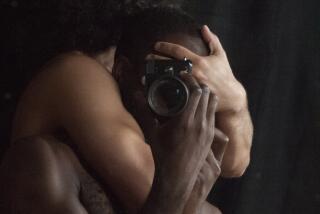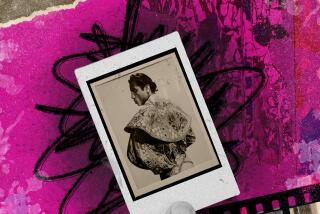‘Two Masters of Lithuanian Photography’ produce a poignant show.
- Share via
Lithuanian photographer Antanas Sutkus moved around the Laband Art Gallery at Loyola Marymount University, pointing to one and then another of his pictures looking out from the wall.
One was of a boy in the Young Pioneers, a Soviet youth group, but he looked more like a melancholy inmate of a concentration camp. After he took that one, the authorities began calling him “the photographic (Alexander) Solzhenitsyn,” Sutkus said through interpreter Victor Plukas, a Lithuanian-American who hosted the photographer in Los Angeles.
“Pioneer children are supposed to be happy, wave flags and smile. Here, they look degenerate,” Sutkus added.
Another photo captures a grim-looking group of flour mill workers. “It tells the truth,” he said. “It reflects the very hard life in the Soviet Union . . . working hard and getting little. The West can’t imagine how it is.”
But not every picture is so melancholy. Love beams from the faces of his own children, who are captured at different ages in four photos, and there is a pensive look and a gentle smile on the face of one old woman.
Sutkus was at the Westchester campus this week for the opening of an exhibit of his work, which is being paired with photography in a markedly different style by fellow Lithuanian Rimantas Dichavicius.
“Two Masters of Lithuanian Photography,” with 60 works by the men, will be on view through Feb. 23. It is the first major U.S. show for the two, who are well-known in Europe.
And current events in the Baltic republics are giving the show an added poignancy, because as democracy and independence continue to be crushed, the harsh truths and the spirit, love, strength and beauty of Lithuania and its people are being felt in the university gallery.
Gallery Director Gordon Fuglie called Sutkus a “humanist who is politically engaged” through his clear, candid photographs that embrace life from political protests to folk festivals.
“He presents psychological profiles of these people,” Fuglie said. “People will come away with a sense of what these people are going through.”
Dichavicius, on the other hand, captures dreamlike, sepia tone images of the female nude and nature. Said Fuglie, “He looks for the purist, most symbolically beautiful in life and nature.”
Dichavicius’ work includes studies of dunes on the Lithuanian coast, as well as nudes reclining on rippling sand or seemingly lost in a romance with nature. Fuglie calls the photos “a metaphor for nature and purity.”
For his part, Sutkus calls his camera a “weapon for the underground,” which he aimed at the stagnation and subjugation of his country. “Photography was like a language,” he said. “I was trying to portray the resistance.”
As he prepared to return to his home in Vilnius, Sutkus was visibly shaken by the scene he had left 10 days earlier, after the Soviet seizure of the Lithuanian radio and television stations that left 14 dead.
“I’m afraid there will be a repressive regime,” he said, predicting that it will eventually end, but only through a tough struggle. “You have to be optimistic. If you’re not, you can’t live.”
Fuglie said the Sutkus and Dichavicius photos are owned by Herbert A. Belkin, who does business in the Soviet Union as owner of a company that reissues foreign music on compact discs. He befriended the photographers, who were anxious for their work to be seen in the West and, in the process, acquired more than 250 of their pictures.
Belkin had provided money for an earlier art show at the university, and when Fuglie saw the photos at Belkin’s Northern California home, the idea for the show was born.
He said it was an instant hit, drawing more than 500 people for the opening reception. Many were from the large Southern California Lithuanian-
American community.
And, he said, the political timing wasn’t deliberate. The show was planned last summer.
What: Two Masters of Lithuanian Photography.
When: Saturday, noon to 4 p.m.; Wednesday-Friday, 10:30 a.m. to 4:30 p.m.; ends Feb. 23.
Where: Laband Art Gallery, Loyola Marymount University, Loyola Boulevard at West 80th Street, Westchester.
Admission: Free.
Information: 338-2880.
More to Read
The biggest entertainment stories
Get our big stories about Hollywood, film, television, music, arts, culture and more right in your inbox as soon as they publish.
You may occasionally receive promotional content from the Los Angeles Times.










